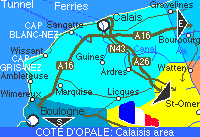|
Places
to visit
|
Where
to eat
| Local
area map |
|
||
|
Calais |
|
|
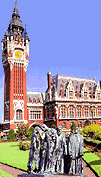 Calais Town Hall with its spectacular belfry, and the famous statue of the Six Burghers by Rodin. |
Welcome to
France! The English bridgehead in
Calais Edward III's siege - the
starving burghers The English army drove out all the inhabitants, and during the occupation Calais was populated by English settlers - merchants, sailors and the defending army. For the English it was a valued bridgehead on the other side of the Channel. English kings clung onto this possession as a base for trade with the Continent, and from which to send their armies into Continental wars. Henry VIII used it as a base for sacking and looting the north of France. Celebrating the
liberation of Calais Many of the new inhabitants were French Protestants, fleeing religious intolerance in other areas of largely Catholic France - bringing their valuable weaving skills with them. To mark the liberation, the town hall has a stained glass window and a statue of the commander of the French army, François Duc de Guise. |
|
After a year of siege, the inhabitants trapped inside Calais were starving. Normally people in a besieged town who fought back would expect to be killed if the attackers succeeded. Six leading citizens offered their own lives if Edward III spared the rest of the townsfolk. His queen took pity on them, and asked if the brave burghers could also be spared if the town surrendered. Edward III agreed. The citizens of Calais lost their homes and property, but were permitted to leave without further bloodshed. |
|
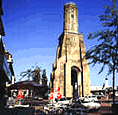 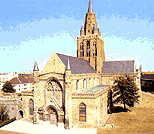 1. 13th century watch tower - part of the medieval walled town captured by the English. 2. Church of Notre Dame - the only English gothic style church in France |
|
|
Calais before World War
2 Another reminder is the church of Notre Dame. Its nave dates back to the 13th century, and it was completed during the English occupation. The old harbour lay under the town walls - now used as a marina for pleasure boats. A model of the old town in the Municipal Museum gives a idea of what it was like. |
|
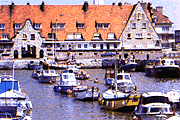 The yacht basin - part of the old harbour before the car ferry docks were built out on the dunes. |
The ferry
port Today's giant car ferries are too big to come into the inner harbour. New berths were constructed from the fifties on, in land reclaimed from the sea and the sand dunes that line the shore from here to Belgium. |
|
Web links
and more information |
|
|||||
|
|
Where to eat
in Calais
- we recommend: |
|||||
|
Places
to visit |
||||||
|
Background information: |
 QUICK TOUR round the Côte d'Opale, starting with Nausicaa... |
|||||
|
|
Vauban
- fortifications |
|||||
|
|
|
|
|
|
|
|
|

